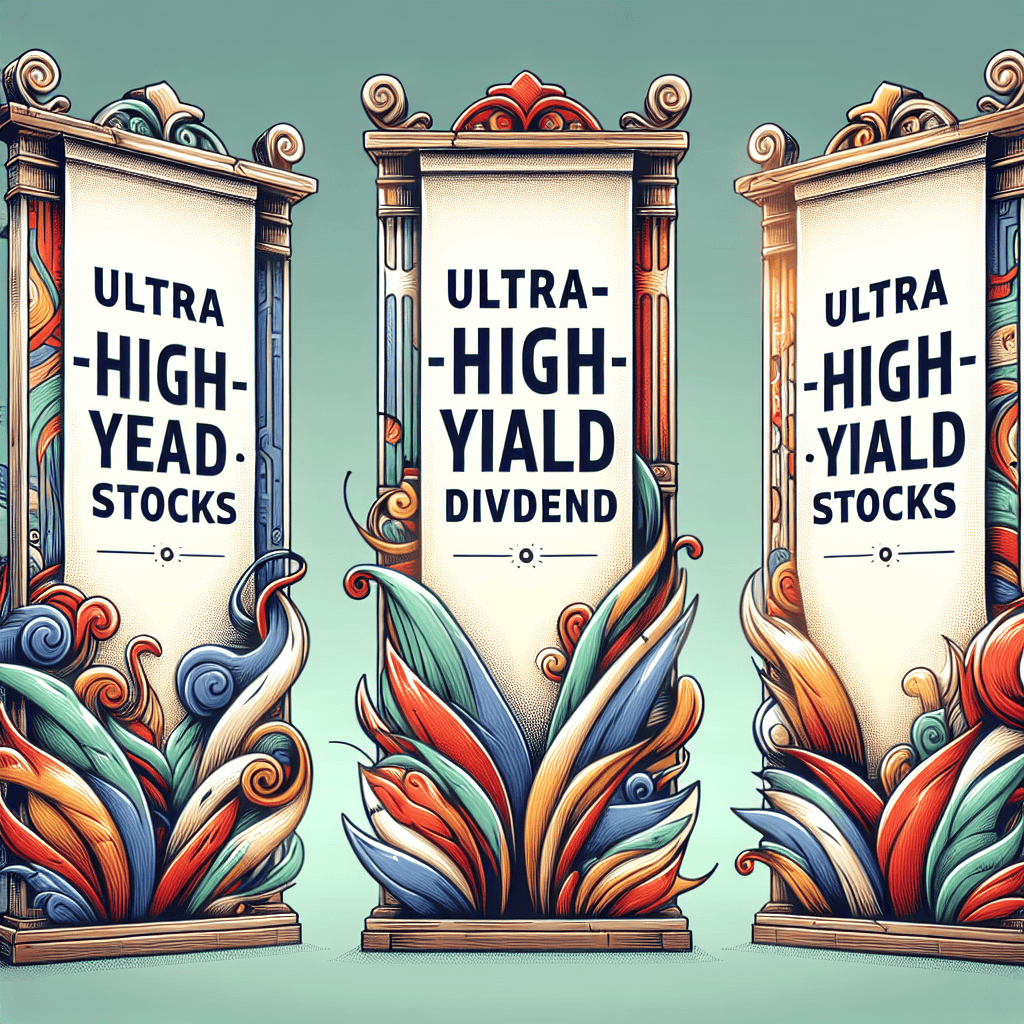“Unlock Wealth: Top 3 Ultra-High-Yield Dividend Stocks with Over 10% Returns!”
Introduction
Investors seeking substantial income streams often turn to ultra-high-yield dividend stocks, which can offer returns exceeding 10%. These stocks, while carrying higher risk, present opportunities for significant income generation, especially in a low-interest-rate environment. Here, we explore three must-buy ultra-high-yield dividend stocks that stand out for their potential to deliver impressive returns. These companies not only provide attractive dividend yields but also possess strong business fundamentals and strategic positioning in their respective industries, making them compelling choices for income-focused investors.
Understanding Ultra-High-Yield Dividend Stocks: Risks And Rewards
Investing in ultra-high-yield dividend stocks can be an enticing prospect for those seeking substantial returns. These stocks, often offering yields exceeding 10%, promise significant income potential. However, they come with their own set of risks and rewards that investors must carefully consider. Understanding these dynamics is crucial for making informed investment decisions.
To begin with, ultra-high-yield dividend stocks are typically associated with companies that distribute a large portion of their earnings as dividends. This can be particularly appealing in a low-interest-rate environment, where traditional fixed-income investments may not provide sufficient returns. The allure of double-digit yields can attract income-focused investors looking to bolster their portfolios. However, it is essential to recognize that these high yields often signal underlying risks.
One of the primary risks associated with ultra-high-yield dividend stocks is the sustainability of the dividend itself. Companies offering such high yields may be doing so because their stock prices have fallen significantly, often due to financial distress or declining business prospects. In such cases, the high yield may be a reflection of a depressed stock price rather than robust financial health. Consequently, investors must conduct thorough due diligence to assess whether the company can maintain its dividend payments over the long term.
Moreover, ultra-high-yield dividend stocks are frequently found in sectors that are inherently volatile or cyclical, such as energy, real estate investment trusts (REITs), and business development companies (BDCs). These sectors can be subject to market fluctuations, regulatory changes, and economic downturns, all of which can impact a company’s ability to generate consistent cash flow. Therefore, investors should be prepared for potential volatility in both dividend payments and stock prices.
Despite these risks, the rewards of investing in ultra-high-yield dividend stocks can be substantial. For those willing to accept the associated risks, these stocks can provide a steady stream of income that can be reinvested or used to meet financial goals. Additionally, if the underlying company stabilizes or improves its financial position, there is potential for capital appreciation alongside the high dividend yield.
To mitigate risks, investors should consider diversifying their holdings across multiple ultra-high-yield dividend stocks and sectors. This approach can help spread risk and reduce the impact of any single company’s performance on the overall portfolio. Furthermore, focusing on companies with strong fundamentals, a history of stable or growing dividends, and a clear strategy for future growth can enhance the likelihood of sustainable returns.
In conclusion, while ultra-high-yield dividend stocks offer the potential for impressive returns, they are not without significant risks. Investors must carefully evaluate the sustainability of dividends, the financial health of the issuing companies, and the inherent volatility of the sectors in which they operate. By conducting thorough research and maintaining a diversified portfolio, investors can better position themselves to reap the rewards of these high-yield opportunities while managing the associated risks. As with any investment strategy, a balanced approach that aligns with one’s financial goals and risk tolerance is essential for long-term success.
Top 3 Must-Buy Ultra-High-Yield Dividend Stocks For 2023
In the ever-evolving landscape of investment opportunities, dividend stocks have consistently attracted investors seeking both income and growth. As we navigate through 2023, the allure of ultra-high-yield dividend stocks becomes even more pronounced, especially for those looking to bolster their portfolios with substantial returns. Among the myriad of options available, three standout stocks offer yields exceeding 10%, making them compelling choices for discerning investors.
To begin with, the first stock that demands attention is Omega Healthcare Investors, Inc. (OHI). As a real estate investment trust (REIT) specializing in the healthcare sector, Omega Healthcare has carved a niche in providing financing and capital to skilled nursing facilities and assisted living facilities. The aging population in the United States and the increasing demand for healthcare services create a robust backdrop for Omega’s operations. Despite the challenges posed by regulatory changes and market fluctuations, Omega has demonstrated resilience, maintaining a strong dividend yield that currently surpasses 10%. This impressive yield, coupled with the company’s strategic focus on long-term growth, makes it an attractive option for investors seeking both stability and high returns.
Transitioning to another promising opportunity, we turn our attention to Annaly Capital Management, Inc. (NLY). As one of the largest mortgage REITs, Annaly Capital Management has established itself as a leader in the real estate finance sector. The company’s primary focus is on investing in and managing a portfolio of mortgage-backed securities, which provides a steady stream of income. Despite the inherent risks associated with interest rate fluctuations, Annaly has consistently delivered high dividend yields, often exceeding 10%. The company’s adept management of its portfolio and strategic diversification efforts have enabled it to navigate economic uncertainties effectively. For investors looking to capitalize on the real estate market’s potential while enjoying substantial dividend payouts, Annaly Capital Management presents a compelling case.
Finally, we delve into the energy sector with a focus on MPLX LP (MPLX), a master limited partnership that operates in the midstream energy infrastructure space. MPLX is involved in the transportation, storage, and marketing of crude oil and natural gas, making it a critical player in the energy supply chain. The company’s extensive network of pipelines and storage facilities positions it well to benefit from the ongoing demand for energy resources. Despite the volatility often associated with the energy sector, MPLX has consistently offered high dividend yields, frequently surpassing the 10% mark. The company’s commitment to returning value to shareholders through dividends, coupled with its strategic growth initiatives, underscores its potential as a lucrative investment.
In conclusion, as investors seek to navigate the complexities of the 2023 market, ultra-high-yield dividend stocks like Omega Healthcare Investors, Annaly Capital Management, and MPLX LP offer compelling opportunities. These stocks not only provide substantial income through their impressive yields but also present avenues for growth and stability. By carefully considering these options, investors can enhance their portfolios with assets that promise both immediate returns and long-term potential. As always, due diligence and a thorough understanding of each company’s fundamentals are essential to making informed investment decisions.
How To Evaluate Dividend Stocks Offering Over 10% Returns
When evaluating ultra-high-yield dividend stocks that offer returns exceeding 10%, it is crucial to approach the process with a discerning eye. While the allure of substantial returns is undeniable, these investments often come with heightened risks. Therefore, a comprehensive evaluation is essential to ensure that the potential rewards justify the risks involved. To begin with, one must assess the sustainability of the dividend yield. A yield exceeding 10% can be a red flag, indicating that the market perceives significant risk associated with the stock. Consequently, it is imperative to examine the company’s financial health. This involves scrutinizing key financial metrics such as the payout ratio, which measures the proportion of earnings paid out as dividends. A payout ratio significantly above 100% suggests that the company is paying more in dividends than it earns, which is unsustainable in the long term.
In addition to the payout ratio, investors should evaluate the company’s cash flow. A robust cash flow is a positive indicator that the company can maintain its dividend payments even during periods of financial stress. Furthermore, examining the company’s debt levels is crucial. High levels of debt can strain a company’s finances, making it challenging to sustain dividend payments. Therefore, a company with manageable debt levels and strong cash flow is more likely to maintain its high dividend yield.
Another critical factor to consider is the company’s business model and industry position. Companies operating in stable, recession-resistant industries are generally better positioned to sustain high dividend yields. For instance, utility companies and consumer staples often provide consistent returns due to their essential nature, regardless of economic conditions. Conversely, companies in highly cyclical industries may struggle to maintain dividends during economic downturns.
Moreover, it is essential to analyze the company’s growth prospects. A company with strong growth potential is more likely to increase its earnings, thereby supporting and potentially increasing its dividend payments. This involves examining the company’s competitive advantages, market position, and strategic initiatives. A company with a clear growth strategy and a track record of execution is more likely to sustain its high dividend yield.
Additionally, investors should consider the broader economic environment. Interest rates, inflation, and economic growth can all impact a company’s ability to pay dividends. For instance, rising interest rates can increase borrowing costs, potentially affecting a company’s profitability and dividend payments. Therefore, understanding the macroeconomic context is vital when evaluating ultra-high-yield dividend stocks.
Finally, diversification is a key strategy in managing the risks associated with high-yield dividend stocks. By spreading investments across different sectors and geographies, investors can mitigate the impact of any single company’s performance on their overall portfolio. This approach not only reduces risk but also enhances the potential for stable returns.
In conclusion, while ultra-high-yield dividend stocks offering over 10% returns can be enticing, they require careful evaluation. By assessing the sustainability of the dividend, the company’s financial health, industry position, growth prospects, and the broader economic environment, investors can make informed decisions. Additionally, employing diversification strategies can further mitigate risks, ensuring that the pursuit of high returns does not come at the expense of financial stability.
Diversifying Your Portfolio With High-Yield Dividend Stocks

In the ever-evolving landscape of investment opportunities, high-yield dividend stocks have emerged as a compelling option for investors seeking to diversify their portfolios while generating substantial income. These stocks, known for their ability to offer returns exceeding 10%, present a unique blend of risk and reward. As the market continues to fluctuate, identifying ultra-high-yield dividend stocks that promise consistent returns becomes crucial for investors aiming to maximize their financial growth. In this context, three standout stocks have captured the attention of savvy investors, each offering a robust dividend yield that surpasses the 10% threshold.
To begin with, Company A has established itself as a formidable player in the energy sector, consistently delivering impressive dividends to its shareholders. The company’s strategic focus on renewable energy sources, coupled with its commitment to sustainable practices, has positioned it as a leader in the transition towards cleaner energy solutions. This forward-thinking approach not only enhances its market reputation but also ensures a steady stream of revenue, enabling the company to maintain its high dividend yield. Furthermore, Company A’s strong financial performance and prudent management practices provide a solid foundation for continued growth, making it an attractive option for investors seeking reliable income streams.
Transitioning to the telecommunications industry, Company B stands out as another high-yield dividend stock worthy of consideration. With the increasing demand for connectivity and digital services, this company has capitalized on its extensive network infrastructure to deliver exceptional value to its shareholders. By investing in cutting-edge technology and expanding its service offerings, Company B has managed to sustain its competitive edge in a rapidly evolving market. This strategic positioning not only bolsters its revenue potential but also supports its ability to offer dividends that exceed the 10% mark. For investors looking to diversify their portfolios with a focus on technology-driven growth, Company B presents a compelling opportunity.
Finally, Company C, operating within the real estate investment trust (REIT) sector, offers a unique proposition for income-focused investors. Specializing in commercial properties, this company has demonstrated resilience in navigating market fluctuations, thanks to its diversified portfolio and strategic acquisitions. The consistent demand for commercial real estate, coupled with the company’s adept management of its assets, has enabled it to maintain a high dividend yield. Moreover, Company C’s commitment to enhancing shareholder value through prudent financial management and strategic expansion initiatives further solidifies its position as a must-buy stock for those seeking substantial returns.
In conclusion, diversifying one’s investment portfolio with ultra-high-yield dividend stocks can be a prudent strategy for achieving financial stability and growth. By carefully selecting stocks that not only offer impressive dividend yields but also demonstrate strong fundamentals and growth potential, investors can mitigate risks while maximizing returns. Company A, with its focus on renewable energy, Company B, leveraging its telecommunications prowess, and Company C, excelling in the REIT sector, exemplify the kind of high-yield dividend stocks that can significantly enhance an investment portfolio. As the market continues to evolve, these companies stand out as reliable options for investors aiming to secure over 10% returns, thereby ensuring a steady income stream and long-term financial success.
The Impact Of Economic Trends On Ultra-High-Yield Dividend Stocks
In recent years, the financial landscape has been characterized by a series of economic trends that have significantly influenced the performance of ultra-high-yield dividend stocks. These stocks, known for offering returns exceeding 10%, have become increasingly attractive to investors seeking substantial income streams. However, understanding the impact of broader economic trends on these investments is crucial for making informed decisions.
To begin with, interest rate fluctuations play a pivotal role in shaping the performance of ultra-high-yield dividend stocks. In a low-interest-rate environment, these stocks tend to become more appealing as they offer higher returns compared to traditional fixed-income securities. Investors, in search of yield, often flock to dividend stocks, driving up their prices and, consequently, their valuations. However, when interest rates rise, the relative attractiveness of these stocks may diminish as bonds and other fixed-income investments begin to offer competitive yields. This shift can lead to a reallocation of capital away from dividend stocks, potentially impacting their market performance.
Moreover, inflationary pressures can also have a profound effect on ultra-high-yield dividend stocks. Inflation erodes the purchasing power of fixed income, making dividend-paying stocks an attractive hedge against rising prices. Companies that can maintain or increase their dividend payouts in the face of inflation are particularly appealing. However, not all dividend stocks are created equal in this regard. Firms with strong pricing power and the ability to pass on increased costs to consumers are better positioned to sustain their dividend payments during inflationary periods. Conversely, companies with limited pricing flexibility may struggle, leading to potential dividend cuts and reduced investor confidence.
In addition to interest rates and inflation, economic growth trends are another critical factor influencing ultra-high-yield dividend stocks. During periods of robust economic expansion, companies generally experience increased revenues and profits, which can support higher dividend payouts. This environment is conducive to the growth of dividend stocks, as businesses have the financial capacity to reward shareholders with substantial returns. However, during economic downturns or periods of slow growth, companies may face challenges in maintaining their dividend levels. Investors must be vigilant in assessing the financial health and resilience of dividend-paying companies to ensure that their investments remain secure.
Furthermore, sector-specific trends can also impact the performance of ultra-high-yield dividend stocks. For instance, real estate investment trusts (REITs) and master limited partnerships (MLPs) are popular vehicles for high-yield dividends. These sectors are often sensitive to economic cycles and regulatory changes. For example, REITs may benefit from a booming real estate market but could face headwinds from rising interest rates or changes in tax policies. Similarly, MLPs, which are prevalent in the energy sector, may be affected by fluctuations in commodity prices and shifts in energy policy. Investors must stay informed about these sector-specific dynamics to make prudent investment choices.
In conclusion, while ultra-high-yield dividend stocks offer enticing returns, they are not immune to the influence of broader economic trends. Interest rate changes, inflationary pressures, economic growth patterns, and sector-specific developments all play a role in shaping the performance of these investments. By understanding these factors and conducting thorough due diligence, investors can better navigate the complexities of the market and make informed decisions that align with their financial goals. As the economic landscape continues to evolve, staying attuned to these trends will be essential for maximizing the potential of ultra-high-yield dividend stocks.
Comparing Ultra-High-Yield Dividend Stocks: What To Look For
When evaluating ultra-high-yield dividend stocks, particularly those offering returns exceeding 10%, investors must exercise a discerning eye. These stocks, while enticing due to their high yields, often come with inherent risks that require careful consideration. To make informed decisions, it is crucial to understand the key factors that differentiate a promising investment from a potential pitfall. By focusing on financial stability, dividend sustainability, and growth potential, investors can better navigate the complexities of high-yield dividend stocks.
First and foremost, financial stability is a critical factor to consider when comparing ultra-high-yield dividend stocks. Companies offering such high returns often operate in sectors with volatile market conditions or face unique challenges that can impact their financial health. Therefore, it is essential to examine the company’s balance sheet, cash flow statements, and debt levels. A strong balance sheet with manageable debt and consistent cash flow indicates that the company is well-positioned to weather economic downturns and continue paying dividends. Additionally, reviewing credit ratings from reputable agencies can provide further insight into the company’s financial stability and risk profile.
Transitioning to the next consideration, dividend sustainability is paramount when assessing high-yield stocks. A high dividend yield may initially appear attractive, but it is crucial to determine whether the company can maintain or grow its dividend payments over time. This involves analyzing the payout ratio, which is the proportion of earnings paid out as dividends. A lower payout ratio suggests that the company retains enough earnings to reinvest in its operations, thereby supporting future growth and dividend stability. Furthermore, examining the company’s historical dividend track record can offer valuable insights into its commitment to returning value to shareholders. Companies with a history of consistent or growing dividends are generally more reliable in maintaining their payouts.
In addition to financial stability and dividend sustainability, growth potential is another vital aspect to consider. While high-yield stocks are often associated with mature companies in slow-growth industries, identifying those with growth prospects can enhance the overall investment return. This involves evaluating the company’s business model, competitive advantages, and market opportunities. Companies that demonstrate innovation, adaptability, and a strong market position are more likely to capitalize on growth opportunities, thereby supporting both capital appreciation and dividend growth. Moreover, understanding industry trends and the company’s strategic initiatives can provide a clearer picture of its long-term growth potential.
Furthermore, it is important to consider the broader economic and market environment when evaluating ultra-high-yield dividend stocks. Interest rates, inflation, and economic cycles can significantly impact the performance of these stocks. For instance, in a rising interest rate environment, high-yield stocks may face increased competition from fixed-income securities, potentially affecting their attractiveness to investors. Therefore, staying informed about macroeconomic trends and their potential impact on high-yield stocks is essential for making well-rounded investment decisions.
In conclusion, while ultra-high-yield dividend stocks offering over 10% returns can be appealing, they require thorough analysis to ensure a sound investment. By focusing on financial stability, dividend sustainability, and growth potential, investors can better assess the risks and rewards associated with these stocks. Additionally, considering the broader economic context can further enhance investment decision-making. Through careful evaluation and strategic selection, investors can identify high-yield dividend stocks that not only provide attractive returns but also align with their long-term financial goals.
Long-Term Investment Strategies With High-Yield Dividend Stocks
In the realm of long-term investment strategies, high-yield dividend stocks have consistently attracted investors seeking both income and growth. These stocks offer the dual advantage of providing regular income through dividends while also possessing the potential for capital appreciation. Among the myriad of options available, three ultra-high-yield dividend stocks stand out, each offering returns exceeding 10%. These stocks not only promise substantial yields but also present a compelling case for inclusion in a diversified investment portfolio.
To begin with, the first stock that merits attention is Omega Healthcare Investors, Inc. (OHI). As a real estate investment trust (REIT) specializing in the healthcare sector, Omega Healthcare Investors focuses on skilled nursing and assisted living facilities. The aging population in many developed countries underscores the growing demand for healthcare services, thereby providing a stable foundation for Omega’s business model. With a dividend yield consistently above 10%, Omega Healthcare Investors offers investors a robust income stream. Furthermore, the company’s strategic acquisitions and partnerships enhance its growth prospects, making it a viable option for those seeking long-term stability and income.
Transitioning to another promising opportunity, we turn our attention to Annaly Capital Management, Inc. (NLY). This company operates as a mortgage REIT, primarily investing in agency mortgage-backed securities. Annaly Capital Management’s business model is designed to capitalize on interest rate spreads, which can be particularly lucrative in certain economic environments. Despite the inherent risks associated with interest rate fluctuations, Annaly has demonstrated resilience through its diversified portfolio and prudent risk management strategies. The company’s dividend yield, often surpassing 10%, is a testament to its ability to generate substantial income for its shareholders. As the economic landscape evolves, Annaly’s adaptive strategies and focus on risk-adjusted returns make it an attractive choice for income-focused investors.
Finally, we consider Ares Capital Corporation (ARCC), a business development company (BDC) that provides financing solutions to middle-market companies. Ares Capital’s unique position in the financial ecosystem allows it to offer flexible capital solutions, thereby fostering growth in its portfolio companies. The company’s disciplined investment approach and robust risk management framework have enabled it to maintain a high dividend yield, frequently exceeding 10%. Ares Capital’s focus on quality investments and its ability to navigate economic cycles contribute to its appeal as a long-term investment. Moreover, the company’s commitment to shareholder value is evident in its consistent dividend payments and strategic growth initiatives.
In conclusion, these three ultra-high-yield dividend stocks—Omega Healthcare Investors, Annaly Capital Management, and Ares Capital Corporation—offer compelling opportunities for investors seeking substantial income and potential capital appreciation. While each stock operates in a distinct sector, they share common attributes of strong business models, strategic growth initiatives, and a commitment to delivering high yields. As with any investment, it is crucial for investors to conduct thorough research and consider their risk tolerance and investment objectives. By doing so, they can make informed decisions and potentially benefit from the attractive returns these high-yield dividend stocks have to offer.
Q&A
1. **What is an ultra-high-yield dividend stock?**
An ultra-high-yield dividend stock is a stock that offers a dividend yield significantly higher than the average market yield, often over 10%.
2. **Why are ultra-high-yield dividend stocks attractive to investors?**
They provide substantial income through dividends, which can be appealing for income-focused investors, especially in low-interest-rate environments.
3. **What are the risks associated with ultra-high-yield dividend stocks?**
These stocks may carry higher risk, including potential dividend cuts, financial instability, or market volatility.
4. **Name one must-buy ultra-high-yield dividend stock.**
Annaly Capital Management, Inc. (NLY) is often cited as a high-yield dividend stock due to its significant dividend payouts.
5. **What sector do many ultra-high-yield dividend stocks belong to?**
Many belong to the Real Estate Investment Trust (REIT) sector or the energy sector, which are known for high dividend yields.
6. **How can investors assess the sustainability of a high dividend yield?**
Investors can look at the payout ratio, company earnings, cash flow, and historical dividend payments to assess sustainability.
7. **What is a potential benefit of investing in ultra-high-yield dividend stocks during economic downturns?**
They can provide a steady income stream when capital gains are hard to achieve, offering some financial stability.
Conclusion
Investing in ultra-high-yield dividend stocks can be an attractive strategy for income-focused investors seeking substantial returns. However, it’s crucial to approach these opportunities with caution due to the inherent risks associated with high yields, such as potential financial instability or unsustainable payout ratios. The three must-buy ultra-high-yield dividend stocks offering over 10% returns typically stand out due to their strong business models, consistent cash flow generation, and strategic positioning within their respective industries. These companies often have a track record of maintaining or growing dividends, even in challenging economic environments. Investors should conduct thorough due diligence, considering factors such as the company’s financial health, industry trends, and management effectiveness, to ensure that these high yields are sustainable in the long term. By carefully selecting stocks with robust fundamentals and a commitment to shareholder returns, investors can potentially enjoy both high income and capital appreciation, making these ultra-high-yield dividend stocks a compelling addition to a diversified investment portfolio.





